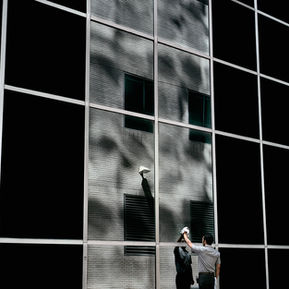FOTOTECA SIRACUSANA
PHOTOGALLERY - FOTOGRAFIA VINTAGE - BIBLIOTECA TEMATICA - CAMERA OSCURA B&W - DIDATTICA
SCRIPTPHOTOGRAPHY
Clarissa BONET (USA)

CLARISSA BONET
Street photography minimalista. Dimenticate il sovraffollamento incoerente di anime anonime riunite occasionalmente nella caotica geometria quotidiana, qui, nelle fotografie di Clarissa Bonet, siamo agli opposti: se la street photography stabilisce un legame tra uomini e lo spazio urbano di cui è artefice, nelle sue immagini Bonet suggella il definitivo incepparsi di questa dinamica: dell’oceano di cemento l’uomo è rimasto vittima, e ad accompagnare i suoi passi sono le lunghissime ombre. E non comunica, né con il suo simile né con il suo spazio. Le persone sono colte tra i bagliori di una luce dilagante, tagliente, che invade le strade e una profonda oscurità che assurgono entrambi al ruolo di una metafora dualistica: luce e tenebre quali elementi divisivi e girevoli, mutevoli, nei quali l’uomo entra ed esce secondando il suo stato d’animo.
La città è una silenziosa prigione dell’uomo e lo spazio fisico somiglia al suo spazio emozionale e psicologico – e ne vediamo gli effetti. Ognuno è assorto, chiuso nella dimensione di un privato impossibile da declinare nell’esperienza comune. E se manca il dialogo ancor più cogliamo l’assenza degli sguardi: gli occhi non ne intercettano altri, e se osservano qualcosa questo è uno spazio infinito – forse il luogo a cui mendicare una risposta. Immagini concettuali, senza dubbio ma restituite, come si direbbe, in “bella forma”, adagiandosi su uno stile rigoroso e in cui il colore sigla un accordo con le plumbee oscurità e le rasoiate di luce. Nemmeno gli “interni” derogano alla compattezza stilistica e concettuale, quasi che Clarissa Bonet fosse sicura che il malessere insegue l’uomo ovunque egli muova i suoi passi; e che si tratti di passeggeri su un mezzo pubblico, mentre fa ingresso nella sua abitazione o mentre è colto da un’improvvisa burrasca, apprendiamo che il disagio, appunto, non lo abbandona. Di più, pare che lo abiti. Eppure, per quanto si vogliano sottolineare le differenze tematiche tra la più classica della street photography e la personale declinazione di Clarissa Bonet, noi vediamo che sono legate dallo stesso filo conduttore, con la differenza che nelle sue fotografie tutto è scarnificato in una direzione espressionista, in un ben riuscito “riassunto” della condizione umana.
Dall’affresco al graffito.
Ottimo lavoro.
Giuseppe Cicozzetti
da "City Space"
foto Clarissa Bonet
Minimalist street photography. Forget the incoherent overcrowding of anonymous souls gathered occasionally in the chaotic everyday geometry, here, in the photographs of Clarissa Bonet, we are on the opposite: if the street photography establishes a link between men and the urban space of which he is the architect, in his images Bonet seals the definitive jamming of this dynamic: the concrete ocean of man has remained a victim, and to accompany his steps are the very long shadows.
And he doesn’t communicate, neither with his similar nor with its space. People are caught in the flashes of a rampant, cutting light that invades the streets and a deep darkness that both take on the role of a dualistic metaphor: light and darkness as divisive and revolving, changing elements, in which man enters and he comes out secondly to his state of mind.
The city is a silent man's prison and physical space resembles his emotional and psychological space - and we see its effects. Everyone is absorbed, closed in the dimension of a private individual who can not be declined in the common experience. And if the dialogue is lacking, we are even more grasped by the absence of glances: the eyes do not intercept others, and if they look at something this is an infinite space - perhaps the place to beg for an answer.
Conceptual images, there’s no doubt but, returned, as you would say, in "beautiful form", resting on a rigorous style and in which the color signs an agreement with the plumberness darkness and the razor of light. Not even the "interiors" derogate from the stylistic and conceptual compactness, as if Clarissa Bonet were sure that the malaise pursues man wherever he moves his steps; and whether it is a passenger on a public transport, while he enters his house or while he’s caught by a sudden storm, we learn that the discomfort, in fact, does not abandon him.
Moreover, it seems that you are wearing it. Yet, as much as we want to underline the thematic differences between the more classical of street photography and the personal declension of Clarissa Bonet, we see that they are linked by the same thread, with the difference that in his photographs everything is stripped in an expressionist direction, in a successful "summary" of the human condition.
From fresco to graffiti.
Giuseppe Cicozzetti
da "City Space"
foto Clarissa Bonet











